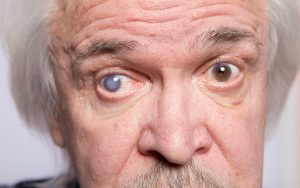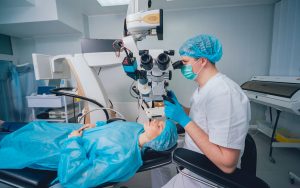Refractive Lens Exchange (RLE) in Myopia
[/vc_column_text][/vc_column][/vc_row][vc_row][vc_column][vc_column_text]Refractive lens exchange is an internal eye procedure similar to cataract surgery in which the natural lens of the patient is replaced with an intraocular lens. In RLE, the patient doesn’t have a cataract which needs to be removed. RLE has led to rapid predictable improvement for those suffering with Myopia. Intraocular lenses eliminate the need for glasses and allows a patient to see at a distance and up close for reading. It can be used to treat astigmatism in some cases. Refractive lens exchange (RLE) can be performed for correction of higher myopia. However, there is a risk for sight threatening myopia, hence appropriate patient selection is critical. A good candidate for RLE is motivated to reduce dependency on or eliminate glasses for those who have myopia, hyperopia, and or astigmatism. RLE is also recommended for those who have Lasik surgery.Preparation for RLE Procedure
A patient and ophthalmologist can discuss various options available for Refractive lens exchange (RLE) surgery. The patient’s eyes are measured to determine the proper power of the intraocular lens that will be placed in the eyes. It is an outpatient procedure and the time varies accordingly. To help you relax when you arrive for surgery, patients may receive eye drops. Surgery is performed for each eye separately. Majority of the patients report improvement in their vision after surgery. On the day of surgery, one can expect anesthesia drops to reduce discomfort and improve overall surgical procedure. A local anesthetic will numb the eye area. With a special instrument, your eyes will remain open. You will see light and movement, but you will not be able to see the surgery while it is happening. A small incision will be made in your eyes under an operating microscope. Microsurgical instruments will be used to break apart and suction the natural lens from your eyes. An intraocular lens implant will be placed inside your eye to replace the natural lens that was removed. The doctor will often place a shield over your eye when surgery is complete.
Final outcome for RLE may take several weeks. However, a patient may complain of blurry vision, glare, or halos in the initial weeks and may experience a scratchy sensation later due to the healing process of the eye after refractive lens exchange (RLE) surgery. Surgery is usually done on an outpatient basis. More than ninety percent of these surgery cases are uncomplicated and result in improved vision with modern technology and excellent surgeon skills. Patients are advised not to rub or press on your eye, as they need to be careful after the surgical procedure is over. If necessary, patients can use over-the-counter pain medicine. Until the eye has healed, very strenuous activities should be avoided and moderate exercise can be done.
Patients need to consult their doctor when they intend to begin driving. As advised by your doctor, patients can wear eyeglasses or shield their eyes.
RLE Surgery Specifications
Refractive lens exchange (RLE) is a vision correction technique, recommended for patients with advanced age. The patients are frustrated with their reading glasses and may suffer with loss of vision. Refractive lens exchange (RLE) is also known as the lifestyle lens because it allows patients to return to many of the activities they enjoy. In refractive lens exchange surgery, the natural lens of the eye is removed and replaced with an artificial intraocular lens to correct and focus the patient’s vision. Surgical procedure of refractive lens exchange (RLE) is quite similar to cataract surgery, which is the most common surgery performed worldwide. Intraocular lens in the eye is accurately measured with advanced equipment. Refractive lens exchange (RLE) treats short-sightedness (myopia) and long-sightedness (hyperopia), however, the most suitable candidates for RLE surgery are bifocal or multifocal wearers in the advanced age group.
RLE Final Assessment
The Refractive Lens Exchange (RLE) procedure involves the intraocular lenses (IOL) as they are flexible. They can fold and fit through the tiny opening. Once inside the eye, they unfold into position. The intraocular lenses are permanen and the procedure takes less than 30 minutes. Patients usually stay longer for approximately 2 hours while recovering. It is advisable that a family member should accompany them during the treatment procedure and drive them back home safely. Usually, the eyes are treated a minimum of one week apart.
Patient will need to arrange for someone to collect them and stay with you at home after the procedure. You should plan to avoid strenuous activity for 48 hours. Until all the drops wear off, your vision may be blurry; however, most patients see well the next day. Your vision will likely fluctuate as the eyes heal and then settle over the first few weeks following refractive lens surgery. This technique is painless for most people. The procedure is performed on one eye the first week, and the other eye the following week. Usually, vision returns quickly and patients can typically drive and work one day after the second eye is treated.[/vc_column_text][/vc_column][/vc_row]




